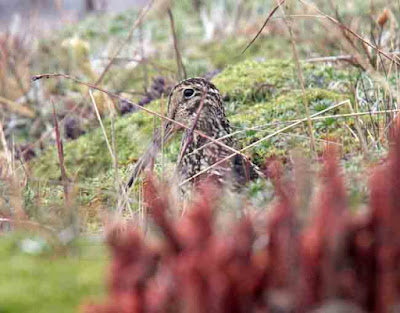Guango Lodge even higher on east slope (GU)
Antisana reserve on the paramo (AN)
The paramo is the term for the tundra above the tree line in the Ecuador Andes. The first location was a short drive from Guango Lodge where it is possible to drive up high enough to see one of Ecuador's target birds. There are some radio antennae on a mountain top and the access road is the only way to somewhat easily find this bird. The guide book says it is a bird of barren slopes at very high elevations on the highest volcanoes. We were at 14,500 elevation. The guide went ahead and searched on the tundra and found a pair and came back to get me. We had to walk about 300 yards up and down muddy hills and I did get the bird. There were a pair of these 12" grouse like birds called Rufous-bellied Seedsnipe (Attagis gayi) Despite their grouse like appearance, the 4 species of seedsnipes make up a family of shorebirds. All are found in South America. They are brick red below with an elaborate scalloped pattern on the back and wings. This is without question the most difficult bird I have ever photographed due to the elevation, cold and wind. Two other cars were up there while we were there, but the birds were a long way from the parking area and the people didn't see them. At the lodge in Mindo, there was a couple from Great Britain and they had looked for the bird on 4 different trips to Ecuador and still had not found it. Thanks Pablo! GU
 |
| Rufous-bellied Seedsnipe |
 |
| Andean Snipe |
 |
| Andean Condor - adult |
 |
| Andean Condor - juvenile male |
 |
| Andean Condor - juvenile male |
 |
| Carunculated Caracara |
 |
| Black-faced Ibis |
Of course, there were some small birds on the paramo as well and 2 of the more interesting were funarids or ovenbirds. The 8" Stout-billed Cinclodes (Cinclodes excelsior) is brown with a white eye-stripe, white throat and thick curved bill. AN
 |
| Stout-billed Cinclodes |
 |
| Many-striped Canastero |
While walking out to see the condor on the carcass, several White-tailed Deer (Odocoileus virginianus), the same species as in North America. They must have migrated south once Panama connected North and South America. AN
 |
| White-tailed Deer |
 |
| Spectacled Bear |
 |
| Spectacled Bear |
Happy birding and photography,
David McDonald
dkmmdpa@gmail.com
photos copyright 2006 - 2016 David McDonald
To have these trip reports sent to your email, please email me at the above address and ask to subscribe.
No comments:
Post a Comment